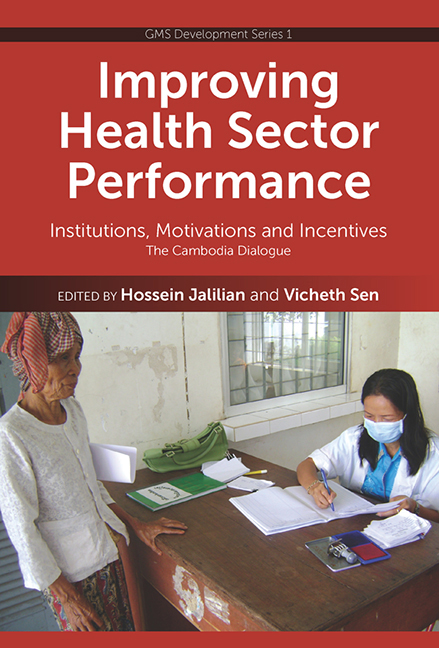 Improving Health Sector Performance
Improving Health Sector Performance from Part V - Health Service Consumer Behaviour
Published online by Cambridge University Press: 21 October 2015
INTRODUCTION
Following more than thirty years of civil war, the genocidal regime of the Khmer Rouge, and global isolation, Cambodia has made a notable movement forward in political, economic, and social development. However, it remains one of the poorest countries in the region, with 35 per cent of the population living below the poverty line (United Nations Development Programme 2009). In spite of investment in the health system, indicators remain poor. According to the 2005 Cambodian Demographic and Health Survey, the maternal mortality ratio is 472 per 100,000, and the infant mortality rate is 66 per 1,000 live births (National Institute of Public Health et al. 2005).
In 1997, the Ministry of Health permitted public health facilities to collect user fees. These fees are used to provide staff incentives, as well as to contribute towards operational costs of the facilities (Annear et al. 2008). Much of the literature on the implications of the user fee system on service utilization has argued that user fees negatively impact families’, particularly poor families’, ability to access services (Jacobs & Price 2004; Jacobs & Price 2006; Jacobs et al. 2007). Very little research has been conducted on treatment-seeking decision making beyond the financial component. One study of dengue-related health-seeking behaviours was conducted in rural Cambodia. This found that biomedical and traditional treatments were sought not solely due to financial accessibility, but also to perceptions of quality of services (Khun & Manderson 2007).
However, an econo-centric approach tends to exclude the more complex factors that affect decision making. Because “illness and care seeking are socially and culturally embedded” (Garro 1998, p. 330), comprehensive understanding of these processes demands an exploration of sociocultural elements. Therefore, utilizing dengue as an example, this chapter seeks to determine what considerations beyond the financial influence a family's decision to seek care for suspected dengue infection. How is dengue locally understood, and what role does this knowledge have in treatment seeking? What type of dengue health education is conducted, and what is its function in decision making? When the decision to seek care is made, what services are accessed?
Dengue is the most widespread vector-borne virus in the world, with approximately 2.5 billion people living in areas of high risk.
To save this book to your Kindle, first ensure no-reply@cambridge.org is added to your Approved Personal Document E-mail List under your Personal Document Settings on the Manage Your Content and Devices page of your Amazon account. Then enter the ‘name’ part of your Kindle email address below. Find out more about saving to your Kindle.
Note you can select to save to either the @free.kindle.com or @kindle.com variations. ‘@free.kindle.com’ emails are free but can only be saved to your device when it is connected to wi-fi. ‘@kindle.com’ emails can be delivered even when you are not connected to wi-fi, but note that service fees apply.
Find out more about the Kindle Personal Document Service.
To save content items to your account, please confirm that you agree to abide by our usage policies. If this is the first time you use this feature, you will be asked to authorise Cambridge Core to connect with your account. Find out more about saving content to Dropbox.
To save content items to your account, please confirm that you agree to abide by our usage policies. If this is the first time you use this feature, you will be asked to authorise Cambridge Core to connect with your account. Find out more about saving content to Google Drive.